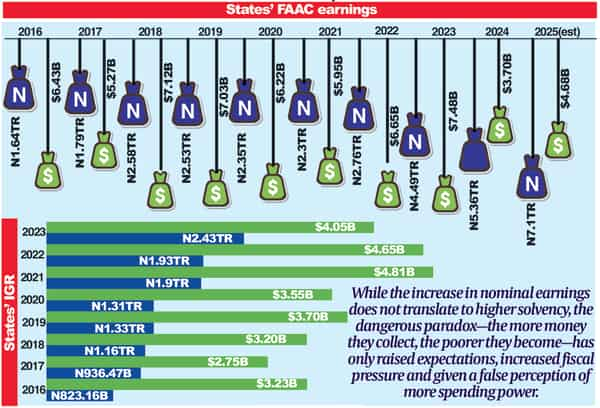• States wealthier in 2022 in dollar terms
• Ambitious expenditure pushing fiscal deficits to N16tr
• FAAC allocations to surpass N7 trillion this year
Nigeria’s sub-nationals may be trapped in money illusion, a deceptive comfort provided by rising allocations given to chief executives who increase their spending without caution for the decaying effect of rising inflation and the shrinking value of the naira on their allocation.
While the increase in nominal earnings does not translate to higher solvency, the dangerous paradox—the more money they collect, the poorer they become—has only raised expectations, increased fiscal pressure and given a false perception of more spending power.
The result is an expansionary fiscal position and bloated recurrent expenditure that feed into rising liabilities, increasing debt accumulation, unfulfilled obligations, unpaid contractors and infrastructure neglect across the country.
From January to August, the state governments earned an average monthly allocation of N593.2 billion from the Federation Account Allocation Committee (FAAC). The amount is 33 per cent higher than last year’s monthly average of N447 billion.
But when adjusted for inflation, considering strictly the current price level, the year-on-year growth in the inflow is less than 10 per cent. Taking 22 per cent as the moving inflation rate, the adjusted monthly earning comes down to N486.2 billion.
In dollar terms, the state governments received approximately $325 million monthly from the common pool compared to $308 million (taking N1450/$ as the average exchange value of the naira last year). The dollar-adjusted value shrinks the expansion even further to 5.5 per cent.
Sadly, capital allocations have suffered even steeper value erosion. Cement, the most basic input in physical infrastructure project execution, has increased by 35 per cent in the past year. This means a state government needs an additional 35 per cent of resources to construct the same quantity of classrooms built last year, assuming cement accounts for 100 per cent of the input (a simplified assumption). Matched with the nominal growth in FAAC allocation, state executives are deprived of the financial capacity to deliver on public goods this year.
Indeed, other inputs (iron, labour and others) have similarly increased—some by as much as 40 per cent. And with states spending more on salaries (with the new minimum wage in full implementation), much of the funds originally earmarked for capital projects are being reallocated to recurrent expenditure, a possibility that may have reduced even the nominal capital expenditure.
In the first eight months of the year, states received a total of N4.75 trillion from the FAAC pool. At the average monthly earnings, the sub-nationals would have earned a total of N7.1 trillion as their share this year, or N1.74 trillion higher than last year’s receipts (N5.36 trillion). If the uptick recorded in July and August, when the monthly disbursement trended up to N660 billion, is sustained, the allocations could rise to N7.5 trillion.
At the most conservative growth scenario, the states would get 33 per cent more in nominal growth terms. With naira devaluation, inflation and bloated recurrent liabilities feasting on the windfalls, the growth amounts to a mere illusion.
But 2025 is a great year overall compared with last year, whether the increase in earnings is considered on face value or real terms. But that stops at only a year-on-year comparison.
A broader horizon view reveals something else. In 2023, disbursements to states totalled N4.49 trillion. That was $7.5 billion in dollar equivalent. That means the sub-nationals would need to receive 60 per cent above the current level to match the 2023 actual allocations.
The inflation-adjusted analysis is not significantly different. The two-year compound inflation is above 60 per cent, putting the inflation-adjusted monthly allocation to the 36 states at N370 billion, about N4 billion less than the monthly distribution of 2023, the transition year of the new fiscal era.
In an actual sense, the states were wealthier in 2022 than they are today. Then, the cumulative FAAC earnings of the sub-national governments were N2.76 trillion. With the naira exchanging for N415/$ (though this was not considered the effective exchange rate, as wide market arbitrage and multiple rates were pervasive), the governors could have been sitting on as much as $6.65 billion plus interest by simply saving the dollar value of their ‘entitlements’.
If one disputes the dollar exchange analysis, the general price level impact on revenue is incontrovertible. In 2022, a tonne of TMT rod, which many contractors use for building, was about N420,000. The essential construction material has soared by nearly 200 per cent to N1.2 million, shrinking the N7.1 trillion annualised state governments’ share from FAAC this year to N2.3 trillion when compared with the real value in the pre-fuel subsidy removal era.
For states, the surge in nominal earnings has not translated to solvency. Across the federation, governments are weighed down by over N3.87 trillion in domestic debts alone (plus billions of dollars in external liabilities) and much more in unpaid arrears to workers and contractors as well as undocumented sundry ‘debts’.
At the heart of this crisis is wealth illusion—the deceptive comfort leaders draw from rising allocations without accounting for inflation and the shrinking value of the naira. While receipts from Abuja look like windfalls, the purchasing power has been eroded by an inflation rate stubbornly high, hovering above 20 per cent.
Instead of adjusting to reality, many states have chosen to splurge on recurrent bills and politically expedient projects, treating paper revenues as evidence of prosperity in the face of weakened fiscal positions.
The problem becomes clearer when viewed against the backdrop of crawling internally generated revenue (IGR). Between 2020 and 2023, states’ IGR rose modestly from N1.33 trillion to N2.43 trillion, about 83 per cent in nominal growth terms. As fast as this important source of financing grows, its contribution to state financing remains far below what is required to sustain rising liabilities and debt servicing that gulps more than half of available earnings in most cases, leaving little for infrastructure and human capital investment.
Besides, the bulk of the IGR of the sub-nationals is generated by Lagos and a few other tier-one states. For instance, in 2023, Lagos, the Federal Capital Territory and three other states held 61 per cent (N1.48 trillion) of the sub-national entities’ IGR.
Despite the poor financial position of states, their chief executives are not slowing down in their spending spree. In 2023, the last comprehensive state-of-the-state report, the total expenditure across 36 states hit N9.78 trillion, increasing by 21.2 per cent from the previous year’s N8.07 trillion. The 2023 total expenditure left in their books a fiscal deficit of N2.86 trillion (41 per cent in terms of their total revenue, which stood at N6.9 trillion) to be funded with fresh borrowings.
This year, the 36 states and the FCT, which are mired in poor funding and oversized debts, are eyeing a combined expenditure outlay of N26.6 trillion. The amount is close to fourfold of The Guardian’s projected N7.1 trillion FAAC windfalls and nearly 400 per cent above last year’s distribution from the federation account.
Unless there is a sort of magic, the IGR will not exceed N3.5 trillion. Its growth, historically, has been kneecapped to around 20 per cent or below. If the trend continues the bullish trajectory and grows by 20 per cent last year (the data are still being compiled) as well as another 20 per cent this year, the states would close the year with independently generated revenue of N3.45 trillion to augment FAAC inflow. These could push the state governments’ composite revenues to N10.5 trillion, a far cry from their ambitious N26.6 trillion expenditure target. This will leave the state governments with a gaping hole of N16 trillion.
According to data provided by BudgIT, a fiscal discipline advocacy organisation, 32 states relied on FAAC receipts for at least 55 per cent of their total revenue in 2023, while 14 states fell back on the source for at least 70 per cent of their revenue in the same year. This underpins the vulnerabilities and poor viability of the political units.
Sub-nationals have been increasingly dependent on overdrafts and bailouts to survive, tending towards insolvency while chasing the mirage of figures that promise much but deliver little.
Except naira holds firm against dollar and the ultra-high inflation decelerates to a single digit, at least, governors, guided by higher paper earnings, will continue to spend money they do not have.






